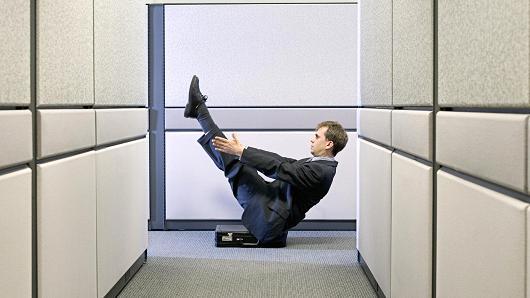In the fiercely competitive environment of Wall Street, almost everyone is looking for an edge—from traders who spend years memorizing the trading patterns of a handful of stocks, to research analysts who dig through their Rolodexes (literal and virtual) to delve into the details of a company’s supply chain.
But some have found another edge, at the end of a yoga mat. Bankers, traders and fund managers are practicing yoga in order to build their mental faculties and improve their ability to focus, claiming that it can serve them well at work.
“You’re constantly looking for an edge on the market, and the focus is always on making your client money. That in itself can be all consuming and stressful,” said Pete Dougherty, a former director at Bank of America Merrill Lynch.
According to the Yoga Journal, the yoga industry was valued at $10.3 billion in 2012, up from $5.6 billion in 2008. The stressful work environment of Wall Street is in many ways ideal for winning new converts.
“The life of a trader is wrought with self-doubt and to a large extent the fear—and at times, expectation—of a negative outcome. Yoga and meditation help to remove these negative blocks and promote self-healing,” said Guy Adami, professional investor and a trader on CNBC’s “Fast Money.”
Adami said that yoga helps to smooth out the emotional “sine curve”—a concept that, according to believers, marks the cycles of a person’s emotional well-being.
“Lengthening the wave length of the curve and shortening the troughs and crests, by definition, is a stress reliever,” said Adami.
“A day after I went to a yoga class, regardless of whether the market was up or down, I’d ask myself why do I feel so good? And then I’d figure out it was because I went to yoga.”
Wall Street employers are taking notice of the popularity of yoga and are catering to the new found interest.
Goldman Sachs currently offers employees 18 on-site yoga classes per week across its New York City; Jersey City, New Jersey; and Irving, Texas, locations.
Steve Doll, equity sales trader at Cowen & Co., said that the first time he tried yoga was by accident.
“I went to my first class (and) thought it would involve more stretching…but I was pleasantly surprised…ended up sweating a ton…that’s when I realized it would be a good stress reliever,” he said.
Those involved in the financial community also said the practice of yoga made them more efficient and alert at work. That’s an important skill to have when working in a fast-paced environment, said Deepak Chopra, meditation guru, author and head of the The Chopra Yoga Center in Toronto and Vancouver.
“Other exercises like running may be a great workout, but the added benefit of yoga is that it offers restful awareness both on and off the mat,” Chopra told CNBC.
Some Wall Streeters agree.
“A day after I went to a yoga class, regardless of whether the market was up or down, I’d ask myself why do I feel so good? And then I’d figure out it was because I went to yoga,” Merrill’s Dougherty said.
Ken Chin, a senior associate at a private equity fund that invests in emerging markets, spends grueling hours at work evaluating prospective deals and building complex models on Excel. Chin said he finds yoga to be an effective “mind, body and soul workout.”
Other finance executives who are said to practice yoga include Bill Gross from bond fund manager Pimco and Ray Dalio of investment firm Bridgewater Associates.
From: CNBC

